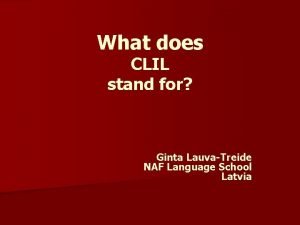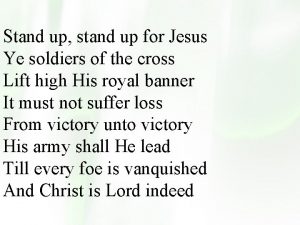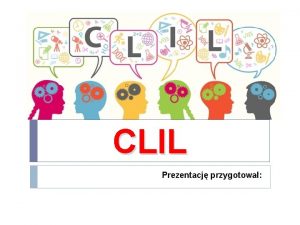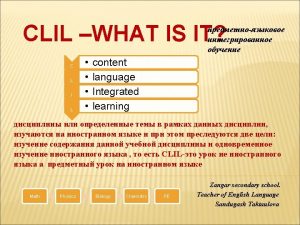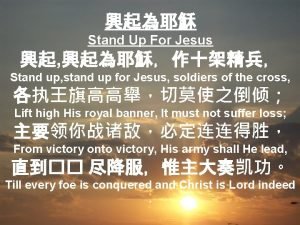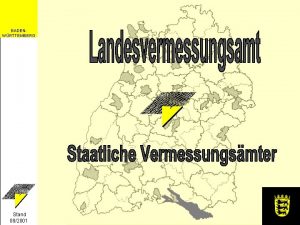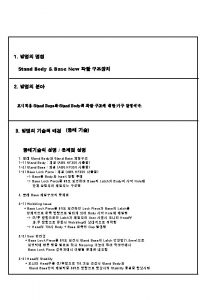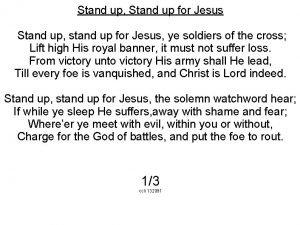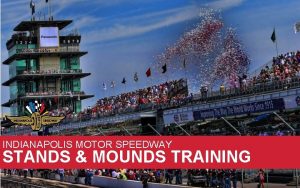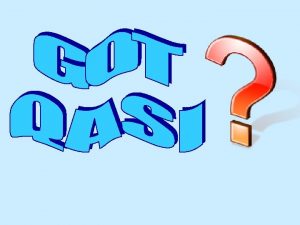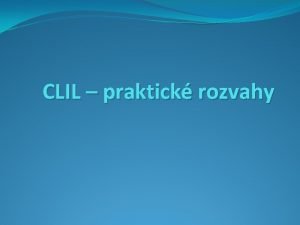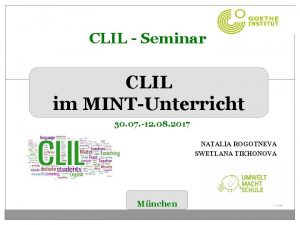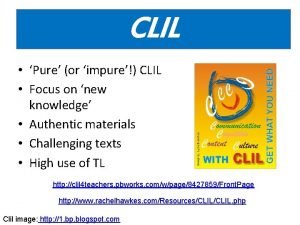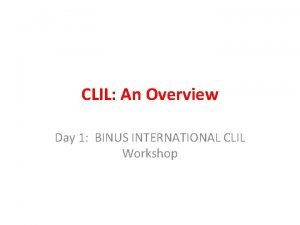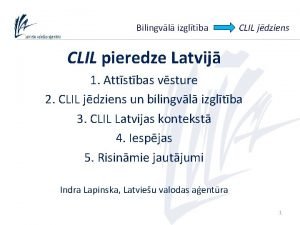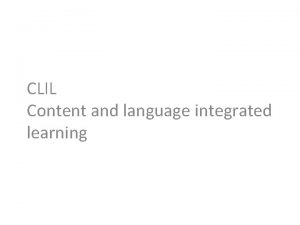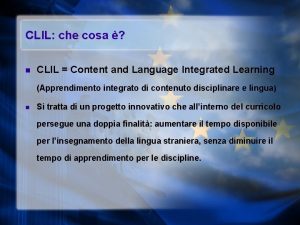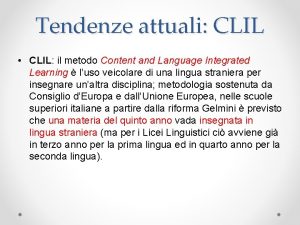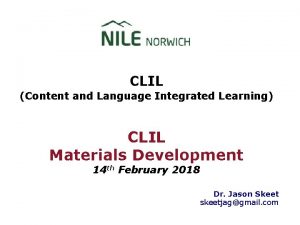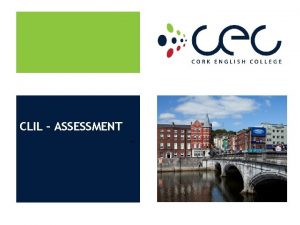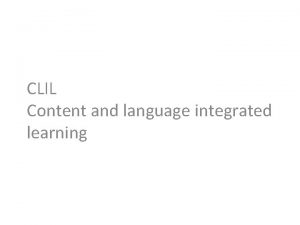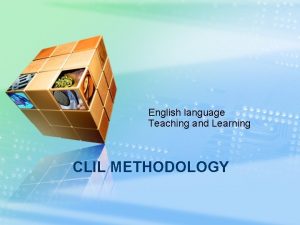CLIL WHAT DOES CLIL STAND FOR CLIL stands

























- Slides: 25

CLIL

WHAT DOES CLIL STAND FOR? • CLIL stands for the following: Content and Language Integrated Learning. • CLIL is an educational approach in which various language-supportive methodologies are used to lead a dual-focused form of instruction where attention is given both to the language and the content.

DEVELOPMENT OF CLIL 1. The Roman Empire expanded and absorbed Greek territory and families in Rome also educated their children in Greek 1. Landmark work by Bruner, Piaget, Vicogtsky and related areas such as multiple intelligences played a key roll in the predevelopment of CLIL 2. There was a need to respond to the interests and concerns: v There was not enough hours allocated for language teaching v Interest in looking at how language teaching could be done while students were learning other subjects, thus providing more exposure to language overall v Better linguistic and communicative competence v More relevant methodologies

DEVELOPMENT OF CLIL 4. The impact of Globalization and the economic and social convergence. 5. Necessity to embrace the findings within SLA (second language acquisition) research 6. It was adopted in 1994 within the European context

SOME ADVANTAGES OF USING CLIL v Increases self confidence and motivation as the language is used to fulfill real purposes to learn the relevant information v Content based information is easier to remember than information based on aspects of grammar and thus leads to deeper learning v By using topics that they are familiar with and, if possible, that they have recently studied in their mother tongue, students will be able to learn more as they will already know a lot of the content and context. v Speaking and thinking in another language not only improves communication skills but also cognitive skills.

OPERATING FACTORS • • • Teacher availibity CLIL language fluency Time Content and language Extra curricular dimension Assesment processes

THE 4 C’S FRAMEWORK The 4 C’s Framework integrates four building blocks: q. Content( subject matter) q. Communication(language learning and using) q. Cognition(learning and thinking processes) q. Culture( developing intercultural understanding and global citizenship)

When planning the content of our lessons, it is essential to think of the knowledge skills, and understanding we want our students to learn more and not only the knowledge they should acquire.

Communication: language is a conduit for communication and for learning , which can be described as learning to use language and using language to learn.

Cognition: Engagement in higher order thinking (analizing, evaluating creating) , understanding , problem solving , and accepting challenges and reflecting on them.

Culture: Self and other awareness , identify, citizenship, and progression towards pluricultural understanding.

Culture Cognition Theme Communication Content Language of learning Language for learning Language through learning

Language of learning This explores what language learners need, to access new knowledge and understanding when dealing with the content. Example: q. Vocabulary and phrases relatad to the topic q. Language of describing , defining, explaining q. Effective use of the tenses of the verb

Language for learning This is linked to the language that children need during the lessons to carry out the planned activities. Example: q. In groups: asking and answering questions using evidence q. Writing a simple research report q. Language to build arguments and disagreements

Language through learning New language will emerge though learning. Not all the CLIL language needed can be planned for. As new knowledge, skills and understanding develop, then so too will new language. Example: q New expressions q New vocabulary q Questioning and answering

REMEMBER…. -The 4 C’s do not exist as separate elements. - However, it is the content which initially guides the overall planning along the learning route.


1 st cycle: Different types of transport Choose which of the pictures correspond to: land , air or water

1 st cycle: 5 senses http: //www. youtube. com/watch? v=OWW 5 Ia. DC j 1 g You will be divided into 5 groups. Each group will represent a particular sense, and you must sing and imitate the teacher, using actions

2 nd cycle: Animals • Answer in groups the 4 questions given about the animal allocated and find the answer by using the treasure map which will lead you to different areas of the corridor labelled A, B, C, D. At area A, B, C, D the children need to look for the corresponding colour • At the area A you will find four different answers to the question : What colour is the animal? . Pick the colour that corresponds to the picture of the animal. • At the area B you will find four different answers to the question : What does he eat? Pick the colour that corresponds to the picture of the animal. • At the area C you will find four different answers to the question : Which is its habitat? Pick the colour that corresponds to the picture of the animal. • At the area D you will find four different answers to the question : Is it a mammal, reptile , bird, fish or amphibian? Pick the colour that corresponds to the picture of the animal.

QUESTIONS • What colour is the animal? • What does it eat? • Which is its habitat? • Is it a mammal, anphibian, reptile , bird ?

2 nd cycle: Advertisement Design and write your own advertisement.

E X A M P L E

3 rd cycle: Introduction to the Evolution of Technology. Put the photos given by teacher in the correct year of the time line.

3 rd cycle: Planets Do you know the names of the planets in order?
 Tarkoma
Tarkoma Stand up for jesus
Stand up for jesus Come on everybody stand up stand stamp your feet
Come on everybody stand up stand stamp your feet Iso 22301 utbildning
Iso 22301 utbildning Typiska novell drag
Typiska novell drag Nationell inriktning för artificiell intelligens
Nationell inriktning för artificiell intelligens Returpilarna
Returpilarna Varför kallas perioden 1918-1939 för mellankrigstiden
Varför kallas perioden 1918-1939 för mellankrigstiden En lathund för arbete med kontinuitetshantering
En lathund för arbete med kontinuitetshantering Särskild löneskatt för pensionskostnader
Särskild löneskatt för pensionskostnader Tidbok för yrkesförare
Tidbok för yrkesförare A gastrica
A gastrica Densitet vatten
Densitet vatten Datorkunskap för nybörjare
Datorkunskap för nybörjare Boverket ka
Boverket ka Debattartikel struktur
Debattartikel struktur Magnetsjukhus
Magnetsjukhus Nyckelkompetenser för livslångt lärande
Nyckelkompetenser för livslångt lärande Påbyggnader för flakfordon
Påbyggnader för flakfordon Formel för lufttryck
Formel för lufttryck Offentlig förvaltning
Offentlig förvaltning Lyckans minut erik lindorm analys
Lyckans minut erik lindorm analys Presentera för publik crossboss
Presentera för publik crossboss Argument för teckenspråk som minoritetsspråk
Argument för teckenspråk som minoritetsspråk Bat mitza
Bat mitza Klassificeringsstruktur för kommunala verksamheter
Klassificeringsstruktur för kommunala verksamheter
